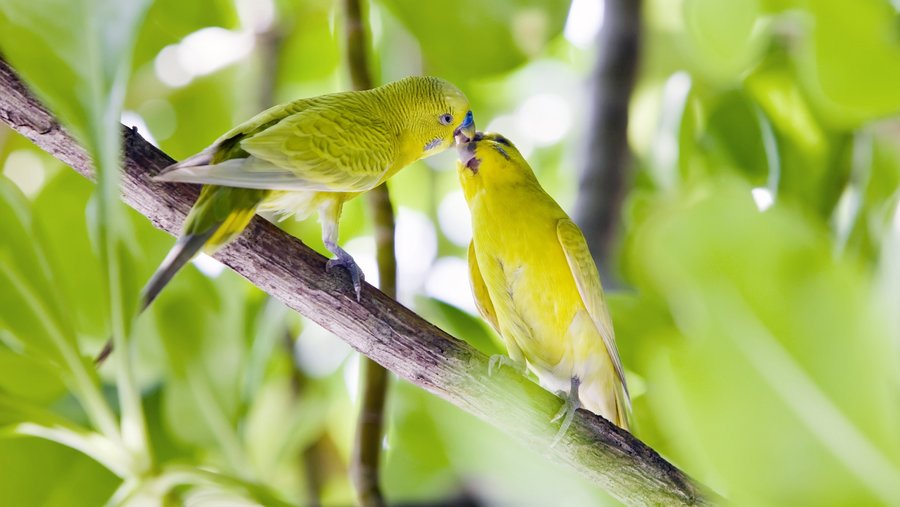Offspring – yes or no? That is the question here.
If you would like to breed offspring, one thing should be clarified above all: Who will take your young budgies later? After all, you can not keep them all in the cage. Ask among your circle of friends or in a reputable pet shop whether someone would like budgies. By the way: If you have a male and female in the cage, this does not mean that there will automatically be offspring. Because budgies are cavity breeders, they definitely need a nesting site that is safe and secure. If the female still lays eggs and you don’t want offspring, simply replace them with plastic eggs; the female will eventually stop breeding.
A place to breed – it should be clean.
You should first look for a suitable nesting place. It is ideally made of wood and has a hole to slip into. Through the hole, the female bird will also be fed by her partner during incubation. It should have space for the hen and at least for six eggs. Unlike zebra finches, budgies do not need additional nesting material. It is enough if it is nice and dark so that the hormones for egg maturation of the female are stimulated. However, a depression for safe egg laying should be provided in the nest box. Cleaning the aviary in advance is also beneficial. An examination to see whether the birds are healthy also makes sense. You may also want to worm them – especially if you keep the budgies in an outdoor aviary.
Get them in a breeding mood – with the right food.
Yes, budgies also need a bit of encouragement to breed. Above all, the food is a decisive criterion. It should be rich in nutrients and minerals in order to ensure that the female budgie stays fit and healthy even during breeding. And egg production in the small body is stimulated. The change in diet also ensures that an optimal amount of nutrients gets into the eggs so that the brood has enough energy reserves and the eggs have a hard, resistant shell. A mineral picking stone or similar should be available a few weeks before hatching begins so that the little body gradually absorbs many minerals. An extra aqua drink instead of regular water can also help. Chickweed and wild grasses are also quite popular during breeding. And, of course, the must-have for all prospective mothers: egg feed. It contains high-quality protein sources from egg and crustaceans and can be moistened slightly with water before feeding. It has a stimulating effect on the birds and helps them get into a breeding mood. Even shortly after the little chicks have hatched, the new bird parents like to take moist food to feed the young brood. It is easier to digest and can also be passed to the chicks better from beak to beak.
Now it’s time to get started – with hatching and rearing.
If all goes well, the female budgie will lay about six eggs in the nest box and hatch them in less than two weeks. Then, after about 18 days, the little chicks will hatch by gradually knocking the eggshell. Once the chicks have freed themselves from the hard shell, they are fed and warmed by their mother immediately after hatching. After all, they are still completely naked and blind. By the way: this is where you should check to see if they all made it or if there is possibly a dead chick in the nest. The first few days, the chicks are still fed with the mother’s forestomach milk. Later, the bird’s father also takes over the role of the provider and feeds them with the grains, vegetables, and green food pre-digested by both. Here, you should also take the precaution of discontinuing additional nutritional supplements. That’s because young birds often react sensitively to an oversupply of vitamins and minerals.
Become a fledging – and off into the wild.
The first feathers appear on the baby budgies after about a week. However, they are still far from being able to fly. It will take about a month before the offspring leave the nest and make their first attempts to flutter. However, they will still be fed by the parents for some time after that. During this time, you will be thrilled to see how much life there is in the nest. After about 10 weeks, the little ones are ready to be released into real life. Perhaps even a little later so that you and your budgies can still enjoy the offspring. But then you should soon give your young budgies to the pre-determined interested parties.
Phew, everything survived well. Are you now ready for the next adventure? However, you should not give your budgies the opportunity to have offspring more than once a year. Because in addition to all the joy, your birds are exposed to a lot of stress. So give yourself some time off. And then you can think again about letting your birds have more offspring.

